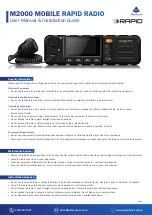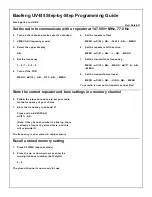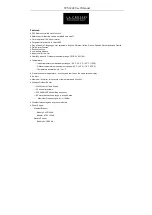
FT-270R O
PERATING
M
ANUAL
63
DCS C
ODE
I
NVERSION
The DCS system was first introduced in the commercial LMR (Land Mobile Radio) service,
where it is now in widespread use. DCS is sometime referred to by its different proprietary
names, such as DPL
®
(Digital Private Line
®
, a registered trademark of Motorola, Inc.).
DCS uses a codeword consisting of a 23-bit frame, transmitted (subaudible) at a data rate of
134.4 bps (bit/sec). Occasionally, signal inversion can result in the complement of a code to
be sent or received. This prevents the receiver’s squelch from opening with DCS enabled,
as the decoded bit sequence would not match that selected for operation.
Typical situations that might cause inversion to occur are:
Connection of an external receiver preamplifier.
Operating through a repeater.
Connection of an external linear amplifier.
Note that code inversion does not mean that any of the above listed equipment is defec-
tive!
In certain amplifier configurations, the output signal (phase) is inverted from the input.
Small signal or power amplifiers having an odd number (1, 3, 5, etc.) of amplification stages
may result in inversion of a transmitted or received DCS code.
While under most circumstances this should not occur (amplifier designs and industry
standards take this into account), if you find that your receiver squelch does not open
when both you and the other station are using a common DCS code, you or the other
station (but not both) can try the following:
1.
Press the [
F/L
] key, then press the [
0
(
SET
)] key to enter the Set mode.
2.
Rotate the
DIAL
knob to select Set Mode Item 14:
DCS.N
/
R
.
3.
Press the [
F/L
] key momentarily, then rotate the
DIAL
knob to
select one of the following modes:
T
/
RX N
:Encoder, Normal; Decoder, Normal
RX R
:
Encoder, Normal; Decoder, Reverse (Inverted)
TX R
:
Encoder, Reverse (Inverted); Decoder, Normal
T
/
RX R
: Encoder, Reverse (Inverted); Decoder, Reverse (In-
verted)
4.
When you have made your selection, press the
PTT
switch to save the new setting
and exit to normal operation.
5.
Remember to restore the default setting to “
T
/
RX N
” (Encoder; Normal, Decoder;
Normal) when done.
M
ISCELLANEOUS
S
ETTINGS
















































